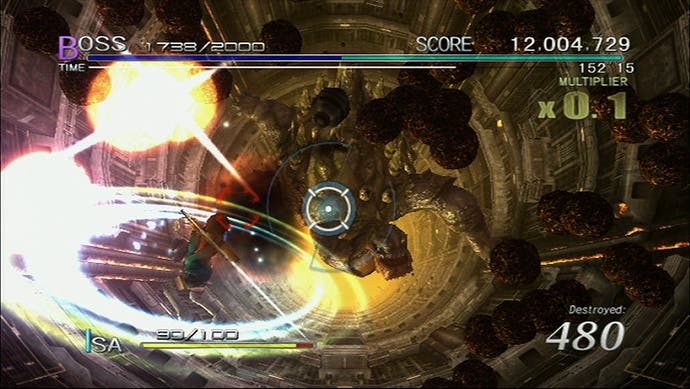Sin and Punishment: Successor of the Skies
Heavens above.
It is, perhaps, the most expensive videogame ever made. Not in the financial sense: Treasure, Japan's small yet consistently brilliant boutique developer has nothing like the resources of its high-profile Western counterparts, as the often-rudimentary graphical assets in this Space Harrier-style shoot-'em-up testify. But in creative terms Sin and Punishment: Successor of the Skies is a high-speed conveyor belt of valuable, distinct ideas, scenes and flourishes that dizzy the mind with their density and inventiveness.
An on-rails shooter, you move into the screen at a steady pace, the camera wheeling and diving as patterns of enemies streak across your fixed path. So nothing in the game is procedural or ad-hoc. There are no freeform battles to intersperse the set-pieces, as in a Halo or Modern Warfare, no moments where the developers can let the AI pad out the experience. Rather, every swoop of an enemy and pivot of a camera has been meticulously orchestrated, an assault of precision-laid creativity. This is a four-hour long rollercoaster ride far more expensive in ideas than any 60-hour RPG epic.
The rules are simple. You fire into 3D landscapes with a steady stream of shots. Lock-on an enemy and the need to keep the reticule manually trained disappears, albeit with a loss of firepower to offset the convenience. Where the first game in the series was locked to the ground, now protagonists Isa and Kachi have jetpacks and hoverboards and can seamlessly take to the skies and descend back into a run with an easing of the analogue stick. While your character exists only on a 2D plane at the foreground of your screen, by tilting and pivoting this angle into the world Treasure creates new, fascinating angles in the game, shifting it from side-scroller to top-down to vertical shoot-'em-up with disorientating yet delightful frequency.

When a foe wanders too close you can strike them away with a close-quarters melee attack, and the move also works to swipe away any rockets, bombs and grenades hurled at you, batting them back at the opposition for a score boost. There is no cover to hide behind, no low walls in whose shelter you can scheme and plot your next move. Instead, you must survive the assault out in the open, bullets and breeze whistling past in a continuous stream of evolving scenes and scenarios. A single multiplier rises with consecutive kills and falls with consecutive hits, a tally readout charting your most recent performance and a modifier that must be carefully capitalised on for leaderboard dominance.
It's in the details that Treasure reveals its flawless pedigree. Your score balloons whenever you manage to set foot on the ground, so running along a derelict motorway will maintain the flow of points into your score tally where tapping up and taking to the air in the jetpack will halt it. The developer plays with convention and genre, including numerous nods to its own back catalogue. A one-on-one boss battle with a flying samurai girl recalls the high-speed freeform face-offs of Bangai-O, while a side-scrolling march through a cyborg factory is every inch Alien Soldier, and an assault on a battleship moored within a sea of lava recalls Radiant Silvergun's most ostentatious set-pieces. One stage has you take the controls of an F-Zero racer, tearing along tarmac and desert in an exhilarating high-speed chase over miles of undulous terrain.








